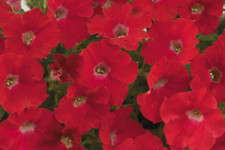Up Close On Ray Petunia

Danziger’s Ray varieties are well established in the marketplace and known to growers for incredible garden performance, dependable plant vigor, superior heat tolerance and improved disease resistance. Plants are covered with an attractive canopy of very large flowers. Flower size measures about 3.5 inches in diameter.
The series includes six breeding innovations: Candy Pink Ray, Purple Ray, Purple Vein Ray, Red Ray, Sun Ray (yellow) and White Ray.
Rays have a naturally compact habit and superior center branching, making for endless possibilities in patio combinations, borders, landscape, hanging baskets, window boxes and pots of all sizes. Rays are self cleaning, easy to grow, sun loving and self maintaining. They are very desirable to the commercial grower and the homeowner.
Culture Tips
Media: Use a sterile, well-drained soil with a pH range of 5.5 to 6.2. Water and let soil dry between irrigations. Too much water, lack of oxygen or poorly drained soils may cause foliar chlorosis similar to yellowing caused by iron deficiency.
Fertilization: Use a balanced feed at 150 to 200 ppm N from a balanced fertilizer on a constant feed basis. To avoid chlorosis, ensure the fertilizer you use contains iron, manganese and magnesium.
Temperature: Best grown in moderate temperatures. During the day, 65 to 70°F is best. At night, 50 to 60°F is ideal.
Photoperiod Management: Provide long-day extensions to at least 13 hours, or as a four-hour night interruption before week 14 to promote flowering. Plants normally flower weeks 7 to 8 from the start of long days.
Light Levels: Plants are best grown under high light. They will benefit from supplemental lighting under low light conditions. Maintain light levels above 4,000 footcandles during late winter months. This will promote better flowering and more compact plants.
Pinching: None required. However, an optional pinch may be given after plants become well established.
Plant Growth Regulators: Petunias, in time, will grow quickly. Low light levels and warmer temperatures can result in stretching. B-Nine (Daminozide) can be effective to control stretching during these times, and also for toning plants in finished pots for the best shelf life. Plants can respond well to Bonzi (Paclobutrazol) and Sumagic (Uniconizole). It is suggested all plant growth regulator rates should be trialed before applications are made to the entire crop to ensure desired results.
Insects Pests: Scout for aphids, thrips and whitefly.
Soil Disease: Botrytis and pythium can result from excessive moisture levels. Stressed roots causing yellowing can resemble nutrient deficiency. Maintain moderate soil moisture levels. Preventative root rot fungicides may be applied if desired.
For more information, visit Danziger.co.il.
0
1
5
Up Close On Ray Petunia





